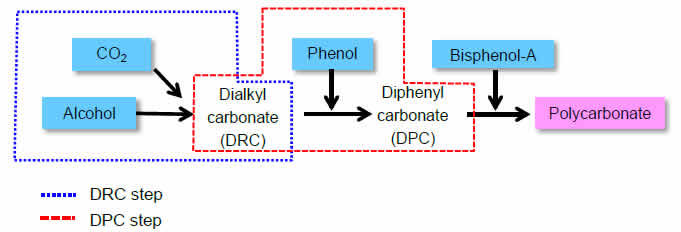Demonstration of validation plant for DRC process to produce DPC, a monomer of PC
―energy-saving production process with low carbon emission and safe feedstock―
Asahi Kasei Corp.
As part of a project of Japan’s New Energy and Industrial Technology Development Organization (NEDO), Asahi Kasei Corp. verified a newly developed process for diphenyl carbonate (DPC), a monomer used to produce polycarbonate (PC), which is used to make parts for vehicles, home appliances, etc., via dialkyl carbonate (DRC), at its Mizushima Works (urashiki, Okayama, Japan). The stability and operability of the process was confirmed through over 1,000 hours of continuous operation. Compared to the conventional process, the new process successfully reduces energy consumption and CO2 emission while using CO2 as a safe feedstock.
Asahi Kasei will continue to verify the economy and energy efficiency of the new process, and work toward its further optimization as a highly energy-efficient process that utilizes CO2.
Outline of the validation plant
- Project period
- Fiscal 2014–2016
- DPC capacity
- 1,000 tons/year
- Location
- Asahi Kasei Corp. Mizushima Works (Kurashiki, Okayama, Japan)
Overview
NEDO is an organization that supports the development of technology which is expected to have high energy-saving effect, mainly emphasizing “important technology” as listed in the Energy Efficiency Technology Strategy. PC is a resin that is widely used in headlamp covers, personal computer housings, CDs, DVDs, etc. Interfacial polymerization1, which uses highly toxic phosgene, is the conventional process to produce PC. In addition to safety issues, the conventional process also has energy consumption issues to be solved. As part of a NEDO project2, in 2015 Asahi Kasei began construction of a validation plant at its Mizushima Works to verify its newly developed process to produce DPC via DRC (the DRC process for DPC) to overcome these issues. Stability and operability as an industrial process was also confirmed through over 1,000 hours of continuous operation. Asahi Kasei has successfully established the non-phosgene process using CO2 as a safe feedstock, enabling not only reduced energy consumption but also reduced CO2 emission.
Asahi Kasei will continue to verify the economy and energy efficiency of the new process, and work toward its further optimization. Specifically, the company aims to achieve commercialization of the new highly energy-efficient process using CO2 with reduced energy consumption through improved yield, and to establish technology for stable production by optimizing operating conditions and equipment. Validation of the new process will strengthen the licensing business Asahi Kasei established with its previously developed non-phosgene process for PC3 which is used around the world including in China, Korea, Taiwan, Russia, and Saudi Arabia.
Results of the validation
The DRC process for DPC utilizes technology which was developed by Asahi Kasei with the support of a NEDO project4, using catalysts to obtain DRC from CO2 and alcohol, and then obtain DPC from DRC and phenol. We have validated the feasibility of the DRC process for DPC through continuous operation to assess catalyst cycling and catalytic performance in both the DRC step, which produces DRC from CO2 and alcohol, and the DPC step, which produces DPC from DRC and phenol, as well as reactor performance and the system to recycle unreacted feedstocks. A flowchart is shown below.

- 1.Confirmed stability and operability as an industrial process through over 1,000 hours of continuous operation.
- 2.Achieved reduced energy consumption and CO2 emission compared with the conventional process for PC.
- 3.Established a production process using CO2 as a safe feedstock instead of highly toxic phosgene. The carbonyl group of polycarbonate is obtained from CO2 rather than from phosgene as with the conventional process.

- 1 Method of polymerization of bisphenol-A and phosgene in two phases of organic phase and aqueous phase.
- 2 Program for Strategic Innovative Energy Saving Technology (2014–2016): Development of process to manufacture chemicals using CO2.
- 3 A process to produce PC using DPC instead of highly toxic phosgene. The process applies melt polymerization of bisphenol-A and DPC.
- 4 Innovation Promotion Program (2010): Development of catalysts having high catalytic activity and high stability.
